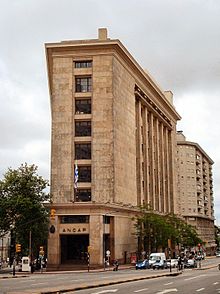 | |
 ANCAP headquarters in Montevideo | |
| Company type | State-owned company (Autonomous State Entity) |
|---|---|
| Industry | Petroleum |
Area served | Uruguay |
Key people | Alejandro Stipanicic (chairman, since 2020) |
| Products | Petroleum products, Portland cement and alcoholic beverages |
ANCAP (Administración Nacional de Combustibles, Alcoholes y Portland, English: "National Administration of Fuels, Alcohols and Portland") is a state-owned company in Uruguay, it was created by Law No. 8.764, on October 15, 1931 during the administration of Gabriel Terra. Its Fundamental Law entrusts it with the power to exploit and administer the monopoly of national Alcohol and Fuel, portland cement, as well as import, refine and sell petroleum derivatives. It operates the only oil refinery in Uruguay in La Teja, inaugurated in 1937 next to its working-class neighborhood with homes with patios and gardens, President Gabriel Terra described the company as the "pride of Uruguay", it has a capacity of 50,000 barrels (7,900 m3) per day.[1] ANCAP has a long-term corporate credit rating "BB−" with positive outlook by Standard & Poor's.[2]
Starting in 1933, he created an alternative fuel of national development based on gasogen (in spanish "gasógeno") that made it possible to overcome the fuel shortage of the World War II almost without difficulties.
In December 2008, ANCAP launched Uruguay's first offshore licensing round, due for completion June 2009. It offered 11 blocks for oil and gas exploration covering areas ranging from 4,000 to 8,000 square kilometres (1,500 to 3,100 sq mi) each, with water depths ranging from 50 to 1,450 metres (160 to 4,760 ft).[3]
In addition to Uruguay, ANCAP operates in Argentina where it owns Petrolera del Cono Sur, operating a petrol station network.[4]
In 2017, ANCAP and UTE opened an electric vehicle network connecting Colonia del Sacramento, Rosario, Puntas de Valdez, Montevideo, San Luis and Punta del Este, with stations every 65 km. The stations at the Carrasco International Airport and Colonia have 43 kW, whereas the other stations have 22 kW.[5]
- ^ "Paraguay/Uruguay". Energy Information Administration. November 2006. Archived from the original on 28 August 2008. Retrieved 4 January 2009.
- ^ "S&P release on Uruguay's ANCAP". Reuters. 22 July 2008. Retrieved 4 January 2009.
- ^ "Uruguay draws interest". Upstream Online. NHST Media Group. 31 October 2008. Retrieved 4 January 2009.
- ^ "Uruguay: Petrolera del Cono Sur lost US$2.98mil". South American Business Information. 19 March 2001. Archived from the original on 23 October 2012. Retrieved 4 January 2009.
- ^ Habrá carga gratuita para autos eléctricos entre Colonia y Punta del Este – El Observador, 27 December 2017